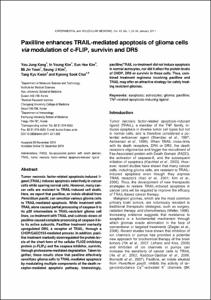Paxilline enhances TRAIL-mediated apoptosis of glioma cells via modulation of c-FLIP, survivin and DR5
- Affiliated Author(s)
- 권택규
- Alternative Author(s)
- Kwon, Taeg Kyu
- Journal Title
- Experimental and Molecular Medicine.
- ISSN
- 1226-3613
- Issued Date
- 2011
- Abstract
- Tumor necrosis factor-related apoptosis-induced ligand
(TRAIL) induces apoptosis selectively in cancer
cells while sparing normal cells. However, many cancer
cells are resistant to TRAIL-induced cell death.
Here, we report that paxilline, an indole alkaloid from
Penicillium paxilli, can sensitize various glioma cells
to TRAIL-mediated apoptosis. While treatment with
TRAIL alone caused partial processing of caspase-3 to
its p20 intermediate in TRAIL-resistant glioma cell
lines, co-treatment with TRAIL and subtoxic doses of
paxilline caused complete processing of caspase-3 into
its active subunits. Paxilline treatment markedly
upregulated DR5, a receptor of TRAIL, through a
CHOP/GADD153-mediated process. In addition, paxilline
treatment markedly downregulated the protein levels
of the short form of the cellular FLICE-inhibitory
protein (c-FLIPS) and the caspase inhibitor, survivin,
through proteasome-mediated degradation. Taken together,
these results show that paxilline effectively
sensitizes glioma cells to TRAIL-mediated apoptosis
by modulating multiple components of the death receptor-
mediated apoptotic pathway. Interestingly,
paxilline/TRAIL co-treatment did not induce apoptosis
in normal astrocytes, nor did it affect the protein levels
of CHOP, DR5 or survivin in these cells. Thus, combined
treatment regimens involving paxilline and
TRAIL may offer an attractive strategy for safely treating
resistant gliomas.
Keywords: apoptosis; astrocytes; glioma; paxilline;
TNF-related apoptosis-inducing ligand
- Department
- Dept. of Immunology (면역학)
- Publisher
- School of Medicine
- Citation
- You Jung Kang et al. (2011). Paxilline enhances TRAIL-mediated apoptosis of glioma cells
via modulation of c-FLIP, survivin and DR5. Experimental and Molecular Medicine., 43(1), 24–34. doi: 10.3858/emm.2011.43.1.003
- Type
- Article
- ISSN
- 1226-3613
- Appears in Collections:
- 1. School of Medicine (의과대학) > Dept. of Immunology (면역학)
- 파일 목록
-
-
Download
 oak-aaa-01838.pdf
기타 데이터 / 1.13 MB / Adobe PDF
oak-aaa-01838.pdf
기타 데이터 / 1.13 MB / Adobe PDF
-
Items in Repository are protected by copyright, with all rights reserved, unless otherwise indicated.